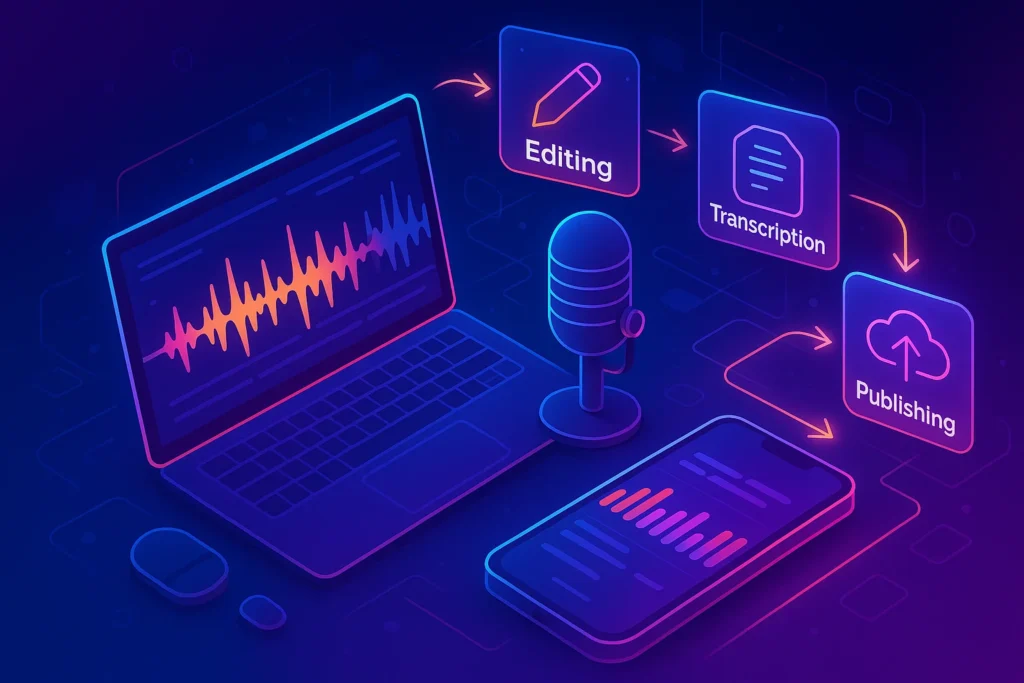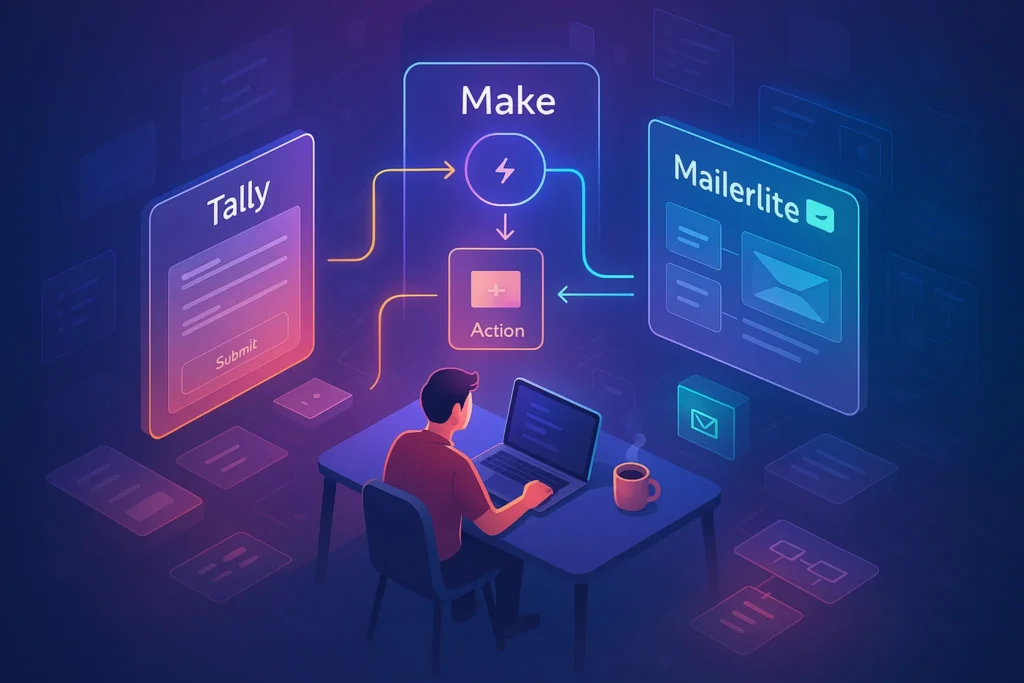Introduction: Why Podcast Automation Matters
Podcasting has exploded into one of the most consumed content formats worldwide, but producing and publishing a show is still a time-heavy process. Recording, editing, adding music, transcribing, publishing to multiple platforms, and promoting on social media can take hours per episode. That workload is one reason many creators give up after just a few episodes.
This is where automation tools come in. By using apps that handle editing, transcription, scheduling, and distribution, podcasters can streamline their workflow and focus more on creating great content rather than getting bogged down in repetitive tasks. Imagine recording your podcast and, within minutes, having an edited episode transcribed, published, and shared across your channels. That’s the power of automation.
In this guide, we’ll explore the best automation tools for podcast production and publishing, show how they fit into a professional workflow, and compare their strengths and weaknesses. Along the way, we’ll connect these tools with related strategies, such as automating your entire content workflow and repurposing content for social media
so you can maximize the reach of every episode you produce.
Descript: Editing and Transcription in One
Descript is often considered the “Swiss army knife” of podcast automation. Its standout feature is text-based editing: you edit your podcast by editing the transcript, just like a Google Doc. The software automatically removes filler words (“uh,” “um”), silences, and background noise, saving hours of manual cutting.
The built-in transcription engine is highly accurate, and automated captions are generated in real time. For creators repurposing podcasts into video snippets or blogs, this is invaluable. You can also use Overdub, Descript’s AI voice tool, to correct mistakes in your audio without re-recording.
What makes Descript particularly appealing is its all-in-one approach. Rather than juggling multiple apps for editing, transcription, and publishing, you can handle most of the process within one platform. That said, its learning curve can be steep for beginners, but once mastered, it feels like having an automated production team at your disposal.
💡 Nerd Tip: Don’t just publish your podcast—repurpose it. With tools like Descript, your transcript becomes ready-made content for blogs and newsletters.
Riverside.fm: Remote Recording Meets Automation
If your podcast relies on remote guests, Riverside.fm is one of the best platforms available. Unlike Zoom or Meet, Riverside records locally in high-quality WAV and MP4 formats, then automatically uploads them to the cloud. This ensures studio-grade quality without dropouts or glitches.
The automation comes in with its “Magic Editor,” which instantly cleans audio, syncs video, and normalizes sound levels. For podcasters publishing video episodes to YouTube or TikTok, the automatic clipping tool identifies highlights and creates short-form content instantly.
For creators who want to edit videos on their phones like a pro, this integration is particularly powerful. Riverside doesn’t just stop at recording—it pushes your workflow forward by creating content formats you can use across platforms without needing manual editing.
📢 Thinking about video podcasting? Tools like Riverside give you professional results without hiring a production crew. If you’re serious about multi-platform reach, this is the easiest upgrade you can make.
Alitu: The “Podcast Maker” for Non-Techies
Alitu is designed for creators who don’t want to deal with the technical side of audio production. You simply upload your raw recording, and Alitu automatically cleans it, levels audio, adds music, and exports a ready-to-publish file.
What sets Alitu apart is its simplicity. Beginners who might be overwhelmed by software like Audition or Logic Pro can rely on Alitu to automate the messy work. It even hosts your podcast and distributes it to platforms like Spotify and Apple Podcasts. That end-to-end automation makes it ideal for solo podcasters or small teams.
This approach resonates with the same ease-of-use mindset as AI video editors built for non-technical creators
It’s not about replacing creativity—it’s about removing the friction of technical barriers so you can focus on the storytelling.
📬 Want More Smart AI Tips Like This?
Join our free newsletter and get weekly insights on AI tools, no-code apps, and future tech—delivered straight to your inbox. No fluff. Just high-quality content for creators, founders, and future builders.
🔐 100% privacy. No noise. Just value-packed content tips from NerdChips.
Podbean: Hosting and Automated Distribution
Publishing is where many podcasters burn out. Uploading to multiple platforms, optimizing metadata, and scheduling releases can eat up valuable time. Podbean solves this by centralizing the process. You upload your episode once, and Podbean automatically publishes it to Spotify, Apple Podcasts, Google Podcasts, and dozens of directories.
Podbean also includes automation for monetization. Dynamic ad insertion allows you to automatically place ads in your back catalog, which means older episodes continue generating revenue without manual updates. For podcasters building long-term archives, this is a game-changer.
When paired with insights from all-in-one marketing platforms Podbean helps podcasters see beyond downloads to actual audience engagement, making your automation workflow both scalable and measurable.
Otter.ai and Trint: Automated Transcription for Repurposing
Podcasters know that written content multiplies reach. Transcripts improve SEO, accessibility, and give you ready material for blog posts, newsletters, and social media snippets. Tools like Otter.ai and Trint specialize in automated transcription.
Otter.ai is particularly strong for live note-taking during interviews, while Trint excels at collaborative editing and exporting content into different formats. Both integrate with publishing workflows, reducing the time between recording an episode and turning it into searchable, repurposed content.
For creators experimenting with automating content repurposing , these tools unlock a multiplier effect. A single podcast episode can generate a blog, a LinkedIn post, and a batch of tweetable insights—without hours of manual labor.
FVL Snapshot: Quick Comparison of Tools
| Tool | Best For | Standout Automation Feature | Learning Curve |
|---|---|---|---|
| Descript | Editing + Transcription | Text-based editing | Medium |
| Riverside.fm | Remote Recording | Magic Editor + Clips | Low |
| Alitu | Beginners | Auto-cleaning + hosting | Very Low |
| Podbean | Distribution + Monetization | Auto-publish + dynamic ads | Low |
| Otter.ai / Trint | Repurposing | Fast transcripts + exports | Low |
Case Study Snapshot: Automation in Action
Consider an independent podcaster who was spending nearly 10 hours per week editing, writing transcripts, and scheduling releases. By integrating an automated editing tool like Descript for quick cuts, Otter.ai for live transcription, and Anchor (or other publishing platforms) for distribution, they reduced their workload to just 3 hours per week. The result was more consistent publishing and more energy left for what matters most: creating content and engaging with listeners. These real-world shifts highlight how automation isn’t just about saving time—it’s about sustaining creativity and avoiding burnout.
Integration Layer: Connecting Podcast Tools to Your Workflow
Automation shines brightest when it doesn’t exist in isolation. For podcasters running content as part of a bigger brand, connecting tools like Zapier or Make with platforms such as HubSpot, Trello, or Notion creates a seamless ecosystem. Imagine recording an episode, having it auto-transcribed, then instantly generating blog drafts, social media snippets, and email announcements—all flowing into the same dashboard. For those already exploring full-stack solutions (like in our post on Pro Tips for Automating Your Entire Content Workflow), podcast automation becomes a natural extension.
ROI and Cost-Benefit: Why It Pays Off
At first glance, paying $15–$50 per month for a tool may seem like another expense. But compare that with hiring a freelance editor ($30–$60/hour) or spending your own evenings tweaking audio manually. Over the course of a year, automation can save thousands of dollars and hundreds of hours. For small creators, this translates into money that can be reinvested in better gear or ads. For agencies and startups, the ROI shows up as capacity: more shows launched, more leads nurtured, and faster growth without ballooning overhead.
Scaling Strategy: From Podcast to Media Engine
Once your production is automated, the next step is scaling your influence. An audio episode can instantly be turned into a video podcast with minimal editing effort, clipped into short-form TikTok/Reels highlights, converted into a newsletter, and even repurposed into SEO-rich blog posts. With automation as the foundation, you’re not just making podcasts—you’re building a content engine that works across channels. Pair this with repurposing workflows and you’ll find your single recording session generating an entire week’s worth of digital presence.
Ethical and Quality Considerations
Automation isn’t a magic bullet. Over-relying on auto-generated edits, AI voices, or templated social posts can strip your podcast of personality and polish. Listeners tune in for authenticity and connection, and they’ll notice if your content starts to feel generic. The sweet spot is using automation for the repetitive groundwork—transcriptions, publishing, metadata—while keeping the creative storytelling, voice, and strategic choices firmly human. Think of automation as your production assistant, not your creative director.
The Future of Podcast Automation (2026 and Beyond)
The next wave of podcast automation is already forming. Expect smarter AI-driven tools that not only edit audio but also detect filler words and cut them automatically while keeping the flow natural. We’ll likely see AI booking agents that reach out to potential guests, analyze their relevance, and slot them into your calendar. Monetization will also get smarter, with automated ad placement that adjusts dynamically to listener behavior. In a few years, creators could be running entire podcast networks with minimal manual effort, freeing them to focus entirely on building communities and ideas.
🧠 Nerd Verdict
Podcast automation isn’t about cutting corners—it’s about scaling your creativity. The best creators aren’t just recording episodes; they’re building ecosystems that turn one recording into ten pieces of content. With Descript for editing, Riverside for recording, Alitu for simplicity, Podbean for publishing, and Otter/Trint for transcription, you have the backbone of a professional, automated podcasting system.
❓ FAQ: Nerds Ask, We Answer
💬 Would You Bite?
If automation could save you 10 hours per week on podcast production, how would you reinvest that time?
Would you double down on content, or finally explore video podcasting? 👇



